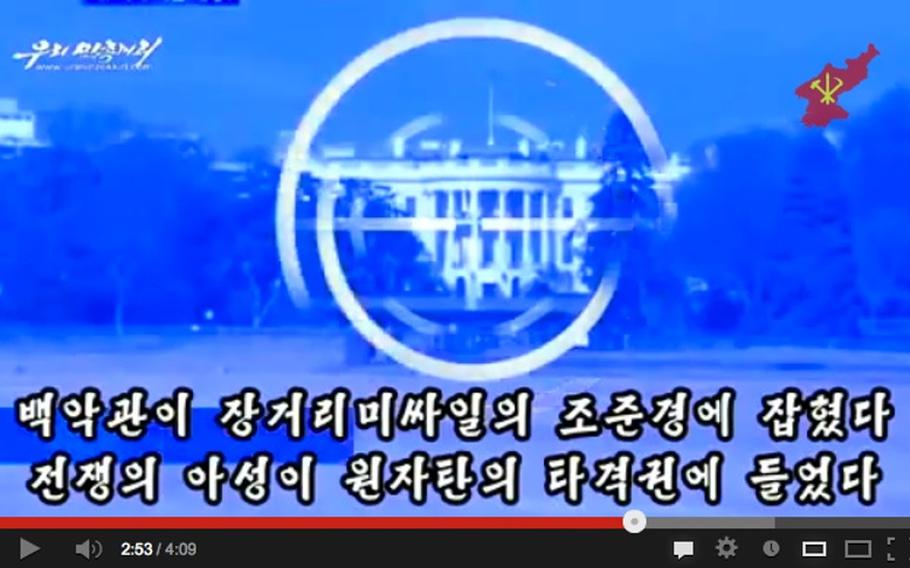
(YouTube video screen grab)
SEOUL — North Korea has posted its most provocative propaganda video to date, showing the White House in its crosshairs and the Capitol Dome exploding.
Meanwhile, for the second time this week, the U.S. military has deployed an impressive piece of U.S. military might on the Korean peninsula — the USS Cheyenne, a nuclear attack submarine.
The two developments underscore how the two countries approach their contentious relationship, with North Korea issuing bellicose bluster in the wake of its third nuclear weapons test and first successful long-range rocket launch, while the U.S. responds with calls for calm even as it ramps up its military capabilities in the region.
Since the United Nations decided to impose new sanctions on North Korea, Pyongyang has unleashed a flurry of threats, including a vow to turn Washington, D.C., and Seoul into a “sea of fire,” and a bizarre video in which an American city burns as an instrumental version of the 1980s song “We Are the World” plays in the background.
This week, Uriminzokkiri — a North Korea propaganda outlet based in China — posted a four-minute video online showing North soldiers and firepower, then the White House in crosshairs and the Capitol Dome exploding, courtesy of a North Korean missile.
An impassioned voiceover boasts that North Korea is now a “nuclear and space power” and warns “American imperialists” not to miscalculate its resolve.
“The White House is now in the sights of a long-range missile,” the video said. “The stronghold of war is within striking distance of an atomic bomb.
“We predict a permanent collapse of American imperialism,” the narrator says.
However, despite North Korea’s recent technological advancements, Washington would appear to still be well beyond its reach. Its three-stage rocket didn’t travel far enough to suggest it could reach the U.S. West Coast, and while its latest nuclear blast was its most powerful yet, there have been no indications that Pyongyang has been able to produce a bomb small enough to fit in a warhead or sturdy enough to survive the stresses of a launch.
Still, a country that has a long history of brinksmanship to gain aid and concessions is clearly trading on its successes. In recent weeks, North Korea has declared that it no longer recognizes the armistice that effectively ended the Korean War, and has once again labeled the joint U.S.-South Korean military exercises now under way on the peninsula as preparations for an attack.
U.S. officials have consistently insisted the annual Foal Eagle and Key Resolve war games are defensive in nature.
Nevertheless, the Pentagon recently announced American missile defense systems in South Korea, Japan and Alaska will be beefed up because of the continuing danger North Korea represents.
This week, nuclear-capable B-52 bombers were brought into South Korea to participate in the ongoing exercises.
Earlier this month, a Korean newspaper, the JoonAng Ilbo, quoted a “high-ranking South Korean government official” as saying unspecified American vessels equipped with nuclear weapons will stay behind in waters off the peninsula after the exercises end to enable the U.S. to respond quickly if the North were to carry out its threats.
Speaking in general terms earlier this week, U.S. Deputy Secretary of Defense Ashton Carter told reporters in Seoul, “We remain steadfast to our commitment to the extended deterrence offered by the U.S. nuclear umbrella, and we will ensure that all of its capabilities remain available to the alliance.”
U.S. military officials here would not confirm or deny the report that nuclear-armed American vessels would remain in South Korean waters in the weeks ahead.
“As a matter of operational security, we don’t discuss the future operations, deployments or plans for our submarines,” a U.S. Navy spokesman said.
A U.S. Forces Korea spokeswoman added that no matter what, if any, changes are made in the deployment of any American assets, “The U.S.-(South Korea) alliance maintains the capabilities to deter, defend against and respond to the threat posed by North Korea.”
Stars and Stripes’ Yoo Kyong Chang contributed to this report.